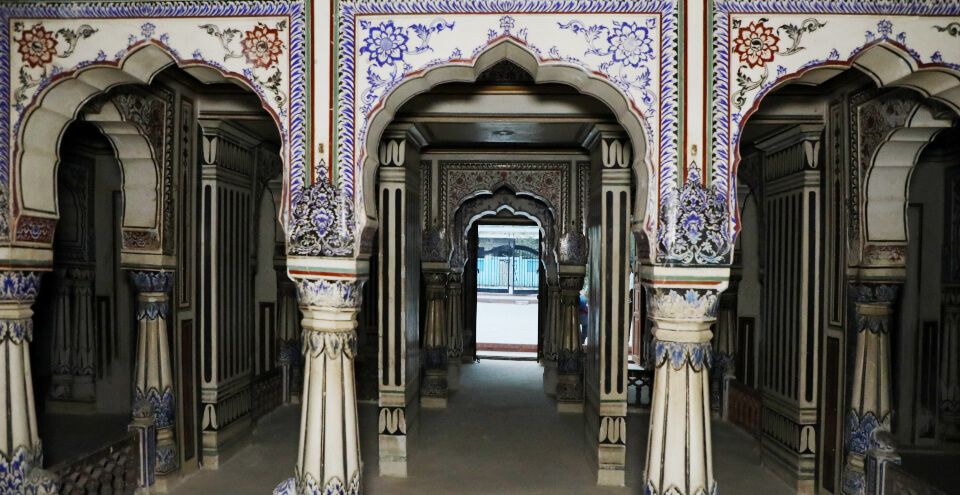
Sunehri Kothi: A Jewel of Rajput Heritage
Sunehri Kothi in Tonk, Rajasthan, is an architectural gem that reflects the opulence and artistic sensibilities of the Rajput era. This historic mansion, known for its exquisite design and intricate craftsmanship, offers visitors a captivating glimpse into the regal lifestyle of the Tonk royal family. Its unique blend of architectural styles and historical significance make it a noteworthy destination in Rajasthan’s rich heritage.
Historical Background
Sunehri Kothi was built in the late 19th century by Nawab Muhammad Ibrahim Ali Pasha, the ruler of Tonk. The mansion was designed as a grand residence, reflecting the Nawab’s taste for luxury and sophistication. The name “Sunehri Kothi,” meaning “Golden Mansion,” signifies the opulence of the building, which was intended to serve as a symbol of the Nawab’s wealth and grandeur.
Architectural and Design Features
1. Regal Architecture
Unique Design: Sunehri Kothi is renowned for its distinctive architectural style, which combines elements of Rajput, Mughal, and European design. The mansion features a blend of intricate carvings, decorative motifs, and elegant facades, showcasing the artistic achievements of the era.
Intricate Carvings: The exterior and interior of the mansion are adorned with detailed carvings and ornamental work. These carvings include floral patterns, geometric designs, and traditional Rajput motifs, reflecting the craftsmanship of the time.
Spacious Layout: The Kothi is designed with a spacious layout that includes multiple rooms, balconies, and courtyards. The layout allows for comfortable living and entertaining, with ample space for relaxation and social gatherings.
2. Artistic Interiors
Opulent Decor: The interiors of Sunehri Kothi are decorated with luxurious furnishings, rich textiles, and exquisite artwork. The use of high-quality materials and intricate designs enhances the overall elegance of the mansion.
Historical Artifacts: The mansion houses several historical artifacts, including antique furniture, paintings, and traditional crafts. These artifacts contribute to the historical and cultural significance of the Kothi.
Grand Hall: The central hall of Sunehri Kothi is particularly impressive, with its high ceilings, ornate chandeliers, and elaborate decorations. This space was designed to host grand events and gatherings.
3. Scenic Surroundings
Elegant Gardens: The Kothi is surrounded by beautifully landscaped gardens, featuring flowering plants, lush greenery, and well-maintained lawns. The gardens provide a serene environment for relaxation and leisure.
Architectural Harmony: The mansion’s design harmoniously integrates with its surroundings, offering picturesque views and a tranquil setting. The architectural style complements the natural beauty of Tonk’s landscape.
Cultural and Historical Significance
Sunehri Kothi represents the opulence and sophistication of the Tonk royal family during the late 19th century. The mansion’s design reflects the Nawab’s appreciation for art, luxury, and cultural diversity. It stands as a testament to the architectural and artistic achievements of the time, showcasing a unique blend of Rajput, Mughal, and European influences.
The Kothi’s historical significance is enhanced by its association with Nawab Muhammad Ibrahim Ali Pasha and the broader history of Tonk. It provides valuable insights into the regal lifestyle and cultural heritage of the region.
Visiting Sunehri Kothi
Sunehri Kothi is located in Tonk, which is approximately 100 kilometers from Jaipur, making it a manageable day trip from the capital city of Rajasthan. The best time to visit is from October to March when the weather is cooler and more comfortable for exploring.
Here are some tips for your visit:
Guided Tours: Consider taking a guided tour of Sunehri Kothi to learn more about its history, architecture, and design. Guides can provide valuable insights into the mansion’s significance and the Tonk royal family.
Photography: Capture the beauty of Sunehri Kothi’s architecture, interiors, and gardens. Be mindful of any restrictions on photography, especially inside the mansion.
Explore Tonk: While visiting Sunehri Kothi, take the opportunity to explore other notable attractions in Tonk, such as the Tonk Fort, the Sunehri Masjid, and the Nawab Saheb’s Gardens. These sites complement your visit and provide a broader view of Tonk’s historical and architectural heritage.
Dress Comfortably: Wear comfortable clothing and footwear for exploring the mansion and its gardens. The terrain around the Kothi can be uneven, so appropriate footwear is essential.
Experience Regal Splendor
Sunehri Kothi in Tonk offers a fascinating glimpse into the regal elegance and artistic heritage of Rajasthan. Its unique architectural style, luxurious interiors, and scenic surroundings make it a remarkable destination for those interested in the history and culture of the Rajput era.
When in Tonk, make sure to visit Sunehri Kothi and immerse yourself in the opulence and charm of this historic mansion. Experience the grandeur of Rajasthan’s royal past and discover the timeless beauty of one of its most exquisite landmarks.
Unveil the regal splendor of Sunehri Kothi, where architectural elegance meets historical richness. Let the mansion’s intricate design and serene surroundings enhance your journey through Tonk and offer a glimpse into the luxurious lifestyle of Rajasthan’s royal heritage.
